Peter Dornauf – 1 January, 2015
In a true ‘age of openness' approach, Dwyer mines the territory that encompasses both expressive and post-painterly abstraction. Between too much emotion and too little, between passionate and super cool, the artist searches for a rapprochement, diving into a space that exists between such contested polarities.
What ever happened to depth? The short answer is it was overtaken by surface. That particular catechism just about sums up the history of art for the last hundred years, with various provisos. The twentieth century’s fascination with flatness - at least its initial penchant for the shallow plane - was engaged with, ironically, in the pursuit of depth. Malevich’s black square or white square was a mystical quest to penetrate the hidden noumenal reality concealed behind the phenomenal world. The artist was a clairvoyant chasing the infinite.
The Russian’s “We must prepare ourselves by prayer to embrace the sky” sounds overblown and simply silly to our ears today. It did to Frank Stella and Donald Judd back in the sixties as they continued the tradition of flatness, but sucked all the metaphysical chest-beating juice out of it - stuff that had attached itself to their fellow countrymen’s work as represented by Pollock and co.
“What you see is what you see” sounded more congenial to ears that were becoming more attuned, post-Holocaust, to sceptical and secular sensibilities in an age when God was truly dead even by radical theological standards. The air had been let out out of the heavens and the universe itself now was fundamentally flat.
The truth of art now became a matter to do with form in space, a response to the reductive shape of solid geometry; cubes made with exactitude and precision, polished and depersonalized and without any allusion to anything outside themselves. There were to be no painterly or expressive touches in this minimalist oeuvre, nothing sublime, visionary or timeless or touching the infinite.
However where the twentieth century history of art was often propelled by forces of reaction - each movement counterpointed by its opposite in a dialectical competitive dance of opposites that produced little synthesis - twenty first century art seems less antagonistically driven.
Contemporary practice favours an exploration of past styles without any rancour. We are more user friendly these days, more open and amicable, reflecting on a greater relaxed, tolerant and relativist age that is less Truth obsessed and orientated. The heat has gone out of the argument.
Abstract Expressionism, with all its transcendental agenda in the 1950s, was scorned by the minimalism of the 1960s, but today, New Zealand artist, Johl Dwyer is less interested in such quarrels and more concerned with the exploration of a place between the two opposing teams; or as American poet John Ashbery put it, “the gap between ideas”.
In a true ‘age of openness’ approach, Dwyer mines the territory that encompasses both expressive and post-painterly abstraction. Between too much emotion and too little, between passionate and super cool, the artist searches for a rapprochement, diving into a space that exists between such contested polarities.
What you see is what you see, plus a little bit more, but not too much more. So in a work entitled Soup, perhaps because the surface has the appearance of such, a little milk added, the piece is flat, minimal, abstract and almost monochromatic except for along the edges where one sees subtle signs of layered colour. This is evident because the surface has been sanded back to reveal not only the wood of the stretcher, but also various colours that were laid down in the process of building the surface. It presents a kind of seepage, a few stains being still extant, evidence of what went into the making. However the finish is all minimal. Its look is low key.
The expressive is thus divulged only in an act of uncovering, in smoothing back a surface that is treated as a kind of archaeological dig - featured only as a recovery, and hence cool. Emotion after the fact.
Malevich gave way to Judd, representing a kind of fundamentalist purity at both ends of the scale. Dwyer explores the middle ground. In this vein he has included in the show a chair/sculpture, a thing that hovers somewhere between the functional - a piece of furniture - and an ‘art object’. Categories are defied in the process.
It was Judd himself, the arch ‘art as object’ practitioner who constructed minimalist furniture, but he was at pains to keep the two separate. Dwyer bridges the gap with his Study, a cubic chair that initially took its form from an old computer programme called Tetris, a Soviet tile-matching puzzle video game, designed by Alexy Pajitnov and released in 1984.
Dwyer pushes the heterogeneous allusions further in his employment of different materials in the construction of the chair. This ‘plural’ chair is made of enamel, cedar, ply, ac anodized aluminium and pine. The varieties of wood with their asymmetrical abutment, evokes all those polished and assorted wooden pencil cases for studious boys from the 1950s. This chair oozes the hybrid and the impure, crossing boundaries and aesthetic time zones.
Such an amalgam of disparate elements sees the artist playing with the sheer delight of materiality while simultaneously engaging with a variety of eclectic referential points. In this he negotiates a territory between being ‘bored with purity’, as Kim Levin once suggested, and the ‘stink of artists’ egos’ as Jasper Johns once so delicately put it.
Dwyer’s paintings also move back and forth between such schisms, falling between something that has sole and sufficient meaning in itself and something possessed of gestural posturing.
The work entitled Far, (enamel, ply, cedar) comes closest to Judd, being essentially a shallow tray upended and hung off the wall, (its depth a product of the frame but lacking the purity of Judd), while Esc approaches a translucent depth that recalls something of a Rothko, albeit it on a miniature scale. However, this latter work does not enunciate something Robert Motherwell once announced when he declared, “the emergence of abstract art is a sign that there are still men of feeling in the world.”
The world since then has become slightly nervous about men’s “feelings”. Much earlier the poet Yeats put the matter succinctly when he wrote, “The best lack all conviction, while the worst are full of passionate intensity.”
Dwyer is essentially dealing with the legacy of formalism, playing with an array of surfaces, experimenting with minimalism, rebooting it into another key, and trying out the range from severe flatness to something a little deeper or a little more expressive - sometimes simply using the joinery in the woodwork to suggest depth. But while so doing, he leaves out all the high rhetoric and transcendental talk, the romanticism and the grandiloquence of supercharged meaning. When he does put the utopian back into the equation, it is always in quotation marks.
Whether playing with - or tweaking - surfaces will prove adequate for people with needs beyond the aesthetics of titivating facades, remains to be seen. For the moment, truth/depth is exposed as another surface, a little colour added.
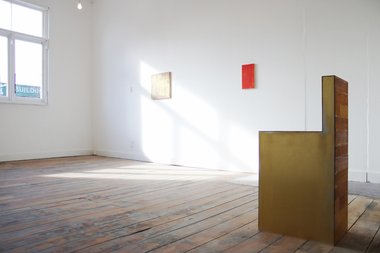
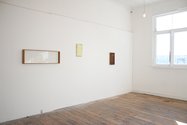


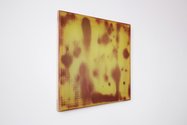
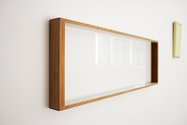
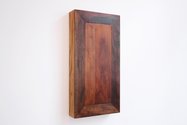


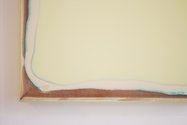

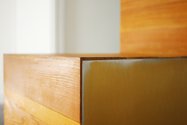
 Advertising in this column
Advertising in this column Two Rooms presents a program of residencies and projects
Two Rooms presents a program of residencies and projects



This Discussion has 0 comments.
Comment
Participate
Register to Participate.
Sign in
Sign in to an existing account.